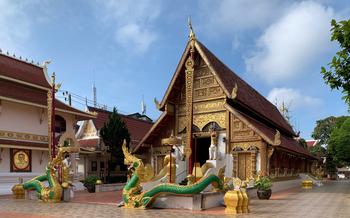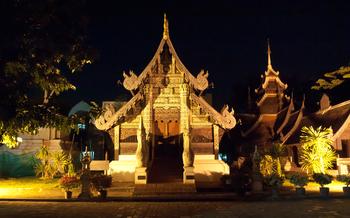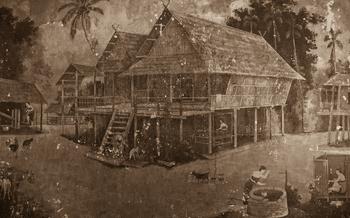
Wat Sri Bun Rueang
- Exploring the Grand Ubosot:
- Marveling at the Exquisite Viharn:
- Unveiling the Chedi
- Exploring the Temple Grounds
- Personal Experience:
- Admiring the Exquisite Murals
- Experiencing the Temple Festivals:
- Paying Respect to the Monks
- Learning about the Temple's History
- Exploring the Surrounding Area
- Planning Your Visit
- Photography and Videography
Exploring the Grand Ubosot:
As we approached the grand ubosot, its intricate architecture immediately captivated my attention. The soaring spires and intricate carvings on the roof were a testament to the artistry and devotion of the temple's builders. The ubosot, or ordination hall, is the most sacred building in the temple complex and serves as a place for important ceremonies and rituals.
The interior of the ubosot was adorned with stunning murals and paintings that depicted scenes from the life of the Buddha and the Jataka tales. The murals were incredibly well-preserved and vibrant, offering a glimpse into the rich cultural and artistic heritage of Thailand.
The ubosot also housed several significant Buddha images, each with its own unique symbolism and significance. The main Buddha image, known as the Phra Buddha Jinaraj, was particularly impressive, exuding an aura of serenity and peace.
I found the atmosphere within the ubosot to be incredibly serene and conducive to meditation. It was easy to see why this sacred space was so revered by the local community. I spent several moments quietly contemplating the beauty of the surroundings and the teachings of the Buddha.
Marveling at the Exquisite Viharn:
The viharn, or assembly hall, of Wat Sri Bun Rueang is a testament to the intricate craftsmanship and artistic prowess of Lanna artisans. Its unique design features a blend of traditional Thai and Burmese elements, showcasing the temple's rich cultural heritage. The viharn's exterior is adorned with intricate carvings and sculptures depicting scenes from Buddhist mythology and the life of the Buddha.
Stepping inside the viharn, visitors are greeted by a serene and awe-inspiring atmosphere. The walls are covered in vibrant murals depicting various Jataka tales, or stories from the Buddha's previous lives. These murals serve as a visual representation of Buddhist teachings and provide valuable insights into the life and philosophy of the Buddha.
The viharn also houses several Buddha images, each with its own unique significance and symbolism. The main Buddha image, known as Phra Phuttha Hong Luang, is a large bronze statue seated in the meditation posture. This revered image is believed to possess great spiritual power and is a focal point of worship for devotees.
Overall, the viharn of Wat Sri Bun Rueang is a masterpiece of Lanna architecture and art. It is a sacred space that invites visitors to contemplate the teachings of the Buddha and experience the tranquility and serenity of this ancient temple.
Unveiling the Chedi
At the heart of Wat Sri Bun Rueang stands the majestic chedi, a towering structure that commands attention and reverence. This sacred monument represents the pinnacle of Buddhist architecture and holds immense religious significance. The chedi's graceful silhouette pierces the sky, symbolizing the Buddha's path to enlightenment and the attainment of nirvana. Its intricate design and architectural features reflect the temple's rich history and artistic prowess.
The chedi's base is adorned with a series of intricate carvings and sculptures, each narrating a story from Buddhist mythology. These bas-reliefs depict scenes of the Buddha's life, his teachings, and the various realms of existence. The intricate details and symbolism embedded in these carvings captivate the viewer's attention and invite contemplation.
As one's gaze travels upward, the chedi's spire emerges, rising majestically towards the heavens. Its graceful curves and tapering form create a sense of lightness and transcendence, symbolizing the Buddha's liberation from earthly desires and his journey to the spiritual realm. The chedi's pinnacle is crowned with a golden stupa, which glistens in the sunlight, radiating an aura of peace and serenity.
The chedi is not merely a monument of architectural beauty; it serves as a focal point for meditation and spiritual contemplation. Devotees often gather around the chedi, offering prayers and paying homage to the Buddha. The serene atmosphere and the sacred energy emanating from the chedi create a conducive environment for reflection and inner peace.
Whether you are a devout Buddhist, a history enthusiast, or simply an admirer of architectural wonders, the chedi at Wat Sri Bun Rueang is a must-see. Its grandeur, symbolism, and spiritual significance make it an unforgettable sight that will leave a lasting impression on your mind and soul.
Exploring the Temple Grounds
As you wander through the temple grounds of Wat Sri Bun Rueang, you'll be struck by the harmonious layout and intricate design. The temple's architecture and landscaping seamlessly blend to create a peaceful and serene atmosphere.
The sprawling temple grounds are dotted with various structures, each serving a specific purpose. There are several smaller shrines dedicated to different deities, as well as a bell tower and a drum tower. These structures add to the temple's charm and provide further insight into the diverse spiritual practices that take place here.
One of the most significant structures on the temple grounds is the sala, a large open pavilion used for community gatherings and events. The sala is often a hub of activity, with locals gathering to socialize, hold meetings, or simply relax and enjoy the peaceful ambiance.
The temple grounds are also home to a beautiful pond, which serves as a serene focal point. The pond is surrounded by lush vegetation and is often visited by birds and other wildlife, adding to the tranquility of the temple's surroundings.
Personal Experience:
During my visit to Wat Sri Bun Rueang, I spent a considerable amount of time exploring the temple grounds. I found it fascinating to observe the different activities taking place and to learn more about the temple's role as a community gathering place. I particularly enjoyed sitting in the sala, soaking in the peaceful atmosphere and watching the locals engage in various activities. The temple grounds are a testament to the vibrant spiritual and cultural life that permeates Wat Sri Bun Rueang.
Admiring the Exquisite Murals
The walls of Wat Sri Bun Rueang are adorned with exquisite murals that depict stories from the life of Buddha, as well as scenes from Thai mythology and history. The murals are a testament to the artistic skill of the Lanna people and provide a glimpse into the beliefs and values of the local community.
The murals are painted in vibrant colors and feature intricate details that bring the stories to life. The artists used a variety of techniques to create depth and realism, including shading, perspective, and the use of light and shadow. The murals are also adorned with gold leaf, which adds to their beauty and opulence.
One of the most striking murals depicts the story of Buddha's life. The mural shows Buddha from his birth to his enlightenment and eventual passing. The mural is a reminder of the importance of Buddha's teachings and the path to enlightenment.
Another notable mural depicts the story of the Thai epic, the Ramayana. The Ramayana is a tale of love, adventure, and redemption, and the mural brings the story to life with its vivid colors and intricate details.
The murals at Wat Sri Bun Rueang are a valuable record of Lanna history and culture. They are a testament to the artistic skill of the Lanna people and provide a glimpse into the beliefs and values of the local community.
Experiencing the Temple Festivals:
Wat Sri Bun Rueang comes alive during its vibrant temple festivals, which are held throughout the year to celebrate important Buddhist holidays and commemorate significant events in the temple's history. These festivals are a kaleidoscope of colors, sounds, and traditions, offering a glimpse into the deep-rooted spirituality and cultural heritage of the local community.
During these festivals, the temple grounds transform into a bustling hub of activity. Devotees from neighboring villages and towns flock to the temple to pay homage to the Buddha, participate in religious ceremonies, and soak in the festive atmosphere. The air fills with the melodious chanting of monks, the rhythmic beating of drums, and the cheerful chatter of people exchanging greetings and sharing stories.
One of the most significant festivals is the annual Songkran Festival, also known as the Water Festival, which takes place in April. During this festival, the temple becomes a scene of joyous water splashing and playful water fights, as people of all ages come together to celebrate the Thai New Year and cleanse themselves of bad luck.
Another important festival is the Visakha Bucha Festival, which commemorates the birth, enlightenment, and passing away of the Buddha. During this festival, the temple is adorned with colorful decorations, and special ceremonies are held to honor the Buddha's teachings and express gratitude for his enlightenment.
Attending a temple festival at Wat Sri Bun Rueang is a truly immersive and enriching experience. It allows visitors to witness the deep devotion and vibrant traditions of the local community, and to gain a deeper understanding of the cultural and spiritual significance of this sacred place.
Paying Respect to the Monks
The monks who reside at Wat Sri Bun Rueang play a pivotal role in the temple's daily life and spiritual practices. They dedicate their lives to studying, meditating, and serving the community. Visitors are encouraged to show respect and offer support to these dedicated individuals.
One way to pay respect is by observing the temple's dress code. Visitors should dress modestly, covering their shoulders and knees. It is also important to be mindful of one's behavior and speech, maintaining a respectful and reverent demeanor.
Visitors may encounter monks engaged in various activities, such as chanting, meditating, or performing ceremonies. It is important to be mindful of their presence and avoid disturbing them. If you wish to interact with a monk, approach them politely and respectfully.
Offerings can be made to the monks as a way of showing gratitude and support. These offerings can be in the form of food, money, or other necessities. Visitors can also offer their time and assistance, helping with tasks such as cleaning or gardening.
Interacting with the monks can be a rewarding and humbling experience. They are a source of wisdom, guidance, and inspiration. Visitors who take the time to connect with the monks will gain a deeper understanding of Buddhism and the temple's significance.
Learning about the Temple's History
Unraveling the rich tapestry of Wat Sri Bun Rueang's history was a captivating experience. The temple's origins can be traced back to the 15th century, when it was established by a group of devout villagers. Over the centuries, the temple underwent several renovations and expansions, each contributing to its unique architectural style and grandeur.
Legends and anecdotes abound, adding to the temple's mystical charm. One tale speaks of a sacred relic, believed to be a Buddha's tooth, that was enshrined within the temple grounds, attracting pilgrims from far and wide. Another story tells of a miraculous event when a fierce storm miraculously spared the temple, leaving it unscathed amidst the devastation that struck the surrounding area.
As I delved deeper into the temple's history, I couldn't help but feel a sense of awe and reverence. Each brick, each carving, and each mural seemed to whisper tales of devotion, resilience, and the enduring spirit of the Thai people. It was a privilege to walk in the footsteps of countless pilgrims and devotees who had sought solace, wisdom, and inspiration within these sacred walls.
Exploring the Surrounding Area
Beyond the confines of Wat Sri Bun Rueang, the surrounding area offers a wealth of hidden gems waiting to be discovered. Immerse yourself in the vibrant history and culture of Lampang by exploring nearby attractions.
Just a stone's throw from the temple, the Kad Kong Ta Street Market beckons with its lively atmosphere and colorful stalls. Experience the local way of life as you browse through an array of fresh produce, traditional handicrafts, and delectable street food. The market is a photographer's paradise, with vibrant colors and friendly locals providing ample opportunities for capturing candid moments.
For a glimpse into Lampang's rich past, visit the Lampang National Museum. This treasure trove of history houses a fascinating collection of artifacts, including ancient pottery, bronze sculptures, and traditional costumes. Learn about the region's fascinating history and the diverse ethnic groups that have shaped its unique identity.
Nature enthusiasts will find solace in the Mae Ping National Park, located just a short drive from the temple. Explore lush forests, cascading waterfalls, and panoramic viewpoints that will leave you breathless. The park offers a variety of hiking trails, ranging from easy walks to challenging treks, providing an opportunity to reconnect with nature and escape the hustle and bustle of city life.
For those seeking a unique cultural experience, the Elephant Conservation Center is a must-visit. Witness the gentle giants in their natural habitat, learn about their behavior and conservation efforts, and even have the opportunity to feed and bathe them. The center provides a rare chance to interact with these magnificent creatures and gain a deeper appreciation for their intelligence and grace.
Whether you're drawn to history, culture, nature, or wildlife, the area surrounding Wat Sri Bun Rueang promises an unforgettable adventure. Embrace the opportunity to explore these hidden gems and create memories that will last a lifetime.
Planning Your Visit
To make the most of your visit to Wat Sri Bun Rueang, it's crucial to plan your trip carefully. The best time to visit is during the dry season, from November to April, when the weather is pleasant and suitable for temple exploration. Aim to arrive early in the morning or late in the afternoon to avoid the midday heat and crowds.
To fully appreciate the temple's grandeur, allocate at least two to three hours for your visit. This will give you ample time to explore the ubosot, viharn, ho trai, chedi, and the surrounding grounds.
To avoid large crowds, consider visiting on weekdays or during the shoulder seasons (May-June and September-October). During these periods, you'll likely have a more intimate and peaceful experience.
Before your visit, it's advisable to do some research on the temple's history, significance, and unique features. This will enhance your understanding and appreciation of the temple's spiritual and cultural importance.
Photography and Videography
When visiting Wat Sri Bun Rueang, it is important to be mindful of the temple's sacred atmosphere and to respect the privacy of the monks and other visitors. Photography and videography are permitted, but visitors are kindly requested to be discreet and to avoid using flash photography or filming religious ceremonies without prior permission.
To capture the best shots of the temple's stunning architecture and intricate details, I recommend using a wide-angle lens or a telephoto lens for close-up shots. The best lighting conditions for photography are usually early in the morning or late in the afternoon when the sunlight casts a warm glow on the temple grounds.
One of my favorite spots for photography is the viharn, where the intricate carvings and sculptures provide endless opportunities for capturing unique and artistic shots. The murals on the walls of the ubosot are also a must-see, and I highly recommend taking the time to study the symbolism and stories depicted in these beautiful artworks.
If you are interested in videography, I suggest creating a short film that showcases the temple's beauty and spiritual significance. You could include footage of the monks chanting, the temple festivals, or the daily life of the temple community. Just be sure to obtain permission from the temple authorities before filming any religious ceremonies or activities.
By following these guidelines and being respectful of the temple's sacredness, you can capture beautiful and meaningful photographs and videos that will serve as lasting memories of your visit to Wat Sri Bun Rueang.



